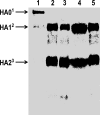Effects of bacterial microflora of the lower digestive tract of free-range waterfowl on influenza virus activation
- PMID: 21531837
- PMCID: PMC3131631
- DOI: 10.1128/AEM.02578-10
Effects of bacterial microflora of the lower digestive tract of free-range waterfowl on influenza virus activation
Abstract
Proteolytic cleavage activation of influenza virus hemagglutinin (HA0) is required for cell entry via receptor-mediated endocytosis. Despite numerous studies describing bacterial protease-mediated influenza A viral activation in mammals, very little is known about the role of intestinal bacterial flora of birds in hemagglutinin cleavage/activation. Therefore, the cloaca of wild waterfowl was examined for (i) representative bacterial types and (ii) their ability to cleave in a "trypsin-like" manner the precursor viral hemagglutinin molecule (HA0). Using radiolabeled HA0, bacterial secretion-mediated trypsin-like conversion of HA0 to HA1 and HA2 peptide products was observed to various degrees in 42 of 44 bacterial isolates suggestive of influenza virus activation in the cloaca of wild waterfowl. However, treatment of uncleaved virus with all bacterial isolates gave rise to substantially reduced emergent virus progeny compared with what was expected. Examination of two isolates exhibiting pronounced trypsin-like conversion of HA0 to HA1 and HA2 peptide products and low infectivity revealed lipase activity to be present. Because influenza virus possesses a complex lipid envelope, the presence of lipid hydrolase activity could in part account for the observed less-than-expected level of viable progeny. A thorough characterization of respective isolate protease HA0 hydrolysis products as well as other resident activities (i.e., lipase) is ongoing such that the role of these respective contributors in virus activation/inactivation can be firmly established.
Figures




References
-
- Aguirre A. A., Quan T. J., Cook R. S., McLean R. G. 1992. Cloacal flora isolated from wild black-bellied whistling ducks (Dendrocygna autumnalis) in Laguna La Nacha, Mexico. Avian Dis. 36:459–462 - PubMed
-
- Byrum B. R., Slemons R. D. 1995. Detection of proteolytic bacteria in the upper respiratory tract flora of poultry. Avian Dis. 39:622–626 - PubMed
-
- Fallacara D. M., Monahan C. M., Morishita T. Y., Wack R. F. 2001. Fecal shedding and antimicrobial susceptibility of selected bacterial pathogens and a survey of intestinal parasites in free-living waterfowl. Avian Dis. 45:128–135 - PubMed
Publication types
MeSH terms
Substances
Associated data
- Actions
- Actions
- Actions
- Actions
- Actions
- Actions
- Actions
- Actions
- Actions
- Actions
- Actions
- Actions
- Actions
- Actions
- Actions
- Actions
- Actions
- Actions
- Actions
- Actions
- Actions
- Actions
- Actions
- Actions
- Actions
LinkOut - more resources
Full Text Sources
Other Literature Sources
Molecular Biology Databases
Research Materials
Miscellaneous

